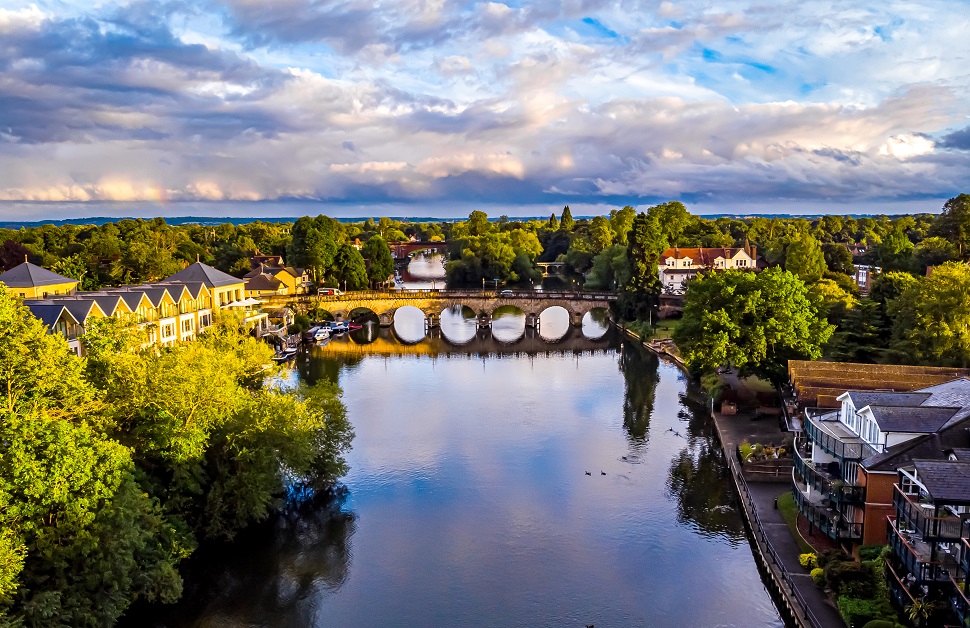Wooded Parts of Berkshire
Found in the South East region, the county of Berkshire boasts a variety of rural and urban areas. Although it is often a recommended location based on the selection of countryside locations all over the county, it is also recognised for its array of built-up parts such as Reading, Slough, Bracknell, Maidenhead, Wokingham, Newbury, Woodley and Windsor.
Out of Berkshire’s total 126,200 hectares of land, 12,800 hectares is occupied by single trees and patches of woodland. Rather than seeing depletion in recent times, it has grown over two decades, increasing by 916 hectares between 2020 and 2022, equating to a positive change of around 6.9%.
A common initiative throughout England, Berkshire’s local authorities and other independent groups are further increasing tree canopy cover by staging exercises in planting more trees. West Berkshire Council alone offers support to residents on planting trees as well as various opportunities for residents to get involved with tree planting, such as for the Great Big Green Week.
All local councils in the country are required to regulate any actions that could cause harm to the environment and biodiversity. Trees feature as a primary natural asset with value and importance, not only due to the impact on nature, but also the ability to absorb carbon dioxide and produce oxygen. In order to avoid potential issues with protected trees on a development site, it would be wise for developers to reach out to an arboriculturist for a tree survey and any other required tree services.

Restrictions Regarding Local Trees
Every part of Berkshire including Bracknell Forest, Reading, Slough, Maidenhead, Windsor and Wokingham will be subject to protections over local trees. Applicable throughout the country, conservation areas and Tree Preservation Orders (TPOs) are common systems that restrict actions around certain individual trees and groups of trees, requiring direct consent before any potentially damaging development works start.
Developers will need to ask for permission from the local council to conduct any work that could impact individual trees under a Tree Preservation Order (TPO) or a selection of trees situated within a conservation area. Aside from applying to singular trees and collective trees, both systems are similar, and finding out whether a tree is protected under either system is often an easy process online.
Berkshire County’s Local Authorities
- Bracknell Forest Council
- Reading Borough Council
- Slough Borough Council
- West Berkshire Council
- Windsor and Maidenhead Council
- Wokingham Borough Council
Tree Assessments
An arboricultural consultant will address trees on the development site by conducting what is known as a BS5837 tree survey. On the day of the arboricultural survey, a professional tree surveyor will visit the site in person and look over all trees present, noting condition and value before handing each tree a grading based on these factors. The predetermined mitigation hierarchy will then be used to determine what the most suitable course of action will be for each tree.
In any situation, retention will be the arboriculturist’s priority, particularly if the trees are in good condition or considered valuable. If any trees are expected to affect the proposed development and plans cannot be changed to cater to them, the trees will need to be relocated elsewhere or destroyed and compensated for with the planting of new trees. It would also be applicable to destroy any trees that are seen as a potential health and safety concern, or simply if they are in poor condition and aren’t worth keeping.
Immediately after the tree survey has concluded, it will then be the job of the tree surveyor to assemble a tree report. In the arboricultural report, all aspects of the inspection will be explained at length, including the assessment process, the arboricultural surveyor’s findings, and next steps that will satisfy the local planning authority. Due to the comprehensive nature of the tree survey report, it should possess all of the information required to prompt a successful application for planning consent.
Talk to Us About Trees on Your Site
If you are concerned that trees on your site could be protected and therefore pose issues to your planning proposal, we would suggest reaching out to our team for a BS5837 tree survey or any other necessary tree surveys early. The alternative would be leaving it late into the planning process and setting yourself up for potentially serious problems. By planning ahead, you can not only eliminate any concerns early, but also choose a time that suits your schedule.
Every time we receive interest from a client, we treat their project with the same level of attention, and as each development is different, we price them up based on their own merits. Due to this, we advise that all clients speak to us so we can send across a free quote based on your specifications. To do this, fill out an enquiry form or call us directly. You can then gain access to a tree report as the result of a tree survey on your site, and once it is passed on to your local planning authority, you should see no further problems with securing planning permission.